Soil microorganisms, the microscopic living organisms found in soil, play a vital role in indoor plant health, performing essential functions such as nutrient cycling, soil structure improvement, biological control of plant pathogens and pests, and direct promotion of plant growth and stress tolerance.
According to a study published in the journal Nature Reviews Microbiology, the global soil microbiome contains an estimated 1 trillion microbial cells per gram of soil, representing thousands of different species, including bacteria, fungi, protozoa, and algae. This complex and diverse community of microorganisms contributes to the health and well-being of indoor plants by working synergistically to create an optimal environment for plant growth.
In this article, we dive deep into the many ways soil microorganisms support indoor plant health and explore how to maintain a healthy soil microbial community to ensure the vitality of your indoor plants.
What are the main types of soil microorganisms essential for indoor plant health?
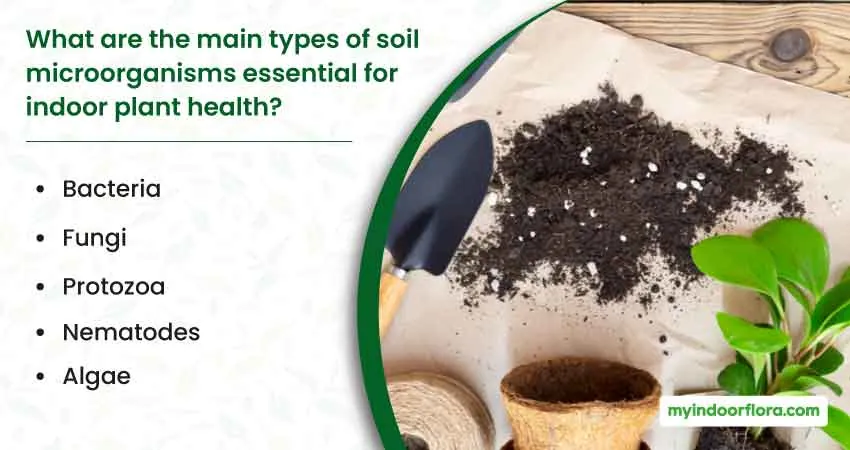
A diverse and thriving microbial community is crucial for indoor plant health. Let’s explore the main types of soil microorganisms that contribute to the well-being of indoor plants.
Bacteria
Bacteria are single-celled microorganisms that can be found in nearly every environment, including indoor plant soil. They are involved in various processes, such as breaking down organic matter, fixing nitrogen, and producing plant growth-promoting substances. Some well-known examples of beneficial bacteria include Rhizobia, which form symbiotic relationships with legumes, and Azospirillum, which can promote growth in several plant species.
Fungi
Fungi play a vital role in the decomposition of organic matter, releasing nutrients that plants can absorb. They also form mutualistic relationships with plant roots, known as mycorrhizal associations, which enhance nutrient uptake and improve plant stress tolerance. Examples of mycorrhizal fungi include Glomus species, which form arbuscular mycorrhizae, and Pisolithus tinctorius, which form ectomycorrhizae.
Protozoa
Protozoa are single-celled eukaryotic organisms that inhabit the soil, feeding on bacteria and organic matter. They contribute to nutrient cycling by releasing nutrients locked up in bacterial cells and enhancing the mineralization of organic matter. Some common types of soil protozoa include amoebae, flagellates, and ciliates.
Nematodes
Nematodes, or roundworms, are tiny soil-dwelling animals that can be beneficial or harmful to plants. Beneficial nematodes feed on bacteria, fungi, and other soil organisms, contributing to nutrient cycling and biological control. Examples of beneficial nematodes include those belonging to the genera Steinernema and Heterorhabditis, which are used as biological control agents against insect pests.
Algae
Algae are photosynthetic microorganisms that live in the soil and can provide additional benefits to indoor plants. They can help fix nitrogen, produce oxygen, and contribute to soil aggregation. Some common soil algae include species from the genera Chlorella and Nostoc.
How do soil microorganisms contribute to nutrient cycling and availability for indoor plants?
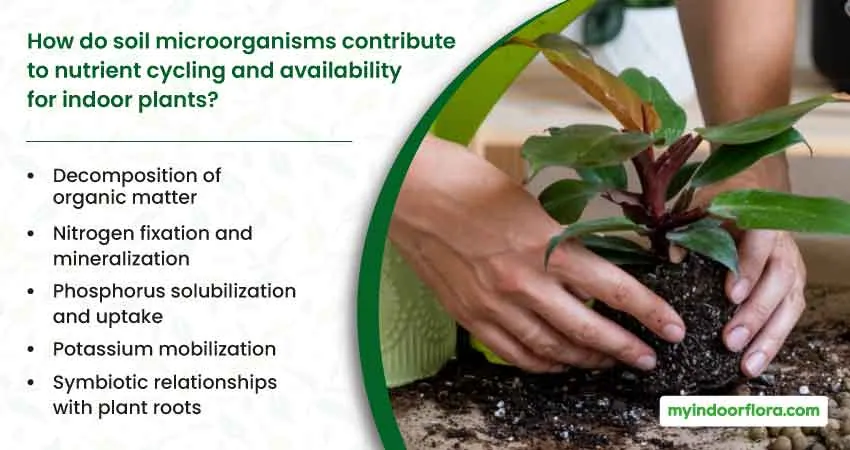
Maintaining nutrient cycling is crucial for indoor plants, and soil microorganisms play a significant role in this process. Let’s delve into the various ways these microscopic organisms contribute to nutrient availability.
Decomposition of organic matter
Soil microorganisms, especially bacteria and fungi, decompose organic matter in the soil, such as dead plant material, animal waste, and other organic residues. This process releases essential nutrients like nitrogen, phosphorus, and potassium, making them available for plant uptake. Decomposition also improves soil structure and water-holding capacity, further benefiting plant growth.
Nitrogen fixation and mineralization
Nitrogen is a critical nutrient for plants, but it is often limited in the soil. Some soil bacteria, such as Rhizobia and Azotobacter, can fix atmospheric nitrogen, converting it into a form that plants can use. Other micro organisms, including bacteria and fungi, participate in nitrogen mineralization, breaking down complex organic nitrogen compounds into simpler forms that plants can absorb. Studies have shown that the presence of these nitrogen-fixing and mineralizing microorganisms can significantly improve plant growth, especially in nutrient-poor soils.
Phosphorus solubilization and uptake
Phosphorus is another essential nutrient for plant growth, but it is often bound in forms that plants cannot use directly. Certain bacteria and fungi, known as phosphate-solubilizing microorganisms (PSMs), can release inorganic phosphate from these unavailable forms, making it accessible to plants. PSMs, such as Pseudomonas and Penicillium, produce organic acids that dissolve the insoluble phosphate compounds, thereby increasing phosphorus availability.
Potassium mobilization
Potassium is a vital nutrient for many plant functions, including water regulation, enzyme activation, and stress response. Soil microorganisms contribute to potassium mobilization by breaking down organic matter and mineralizing potassium compounds, making them available for plant uptake. Certain bacteria, known as potassium-solubilizing bacteria (KSB), can release potassium from unavailable forms, further improving potassium availability in the soil.
Symbiotic relationships with plant roots
Many soil microorganisms form symbiotic relationships with plant roots, mutually benefiting both parties. For example, mycorrhizal fungi colonize plant roots and extend their hyphae into the soil, increasing the root surface area and enhancing nutrient uptake, particularly phosphorus. In return, plants provide the fungi with carbohydrates for growth and reproduction. This symbiotic association has been shown to improve plant growth, nutrient uptake, and stress tolerance.
How do soil microorganisms improve soil structure for indoor plants?
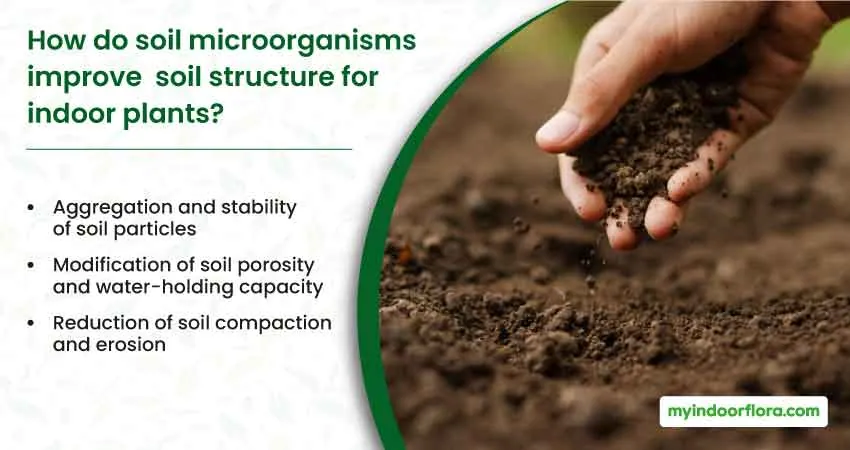
Soil structure plays a vital role in plant growth by influencing water and nutrient availability, aeration, and root penetration. Soil microorganisms contribute to soil structure improvement in several ways.
Aggregation and stability of soil particles
Microorganisms, particularly bacteria and fungi, produce extracellular substances such as polysaccharides, proteins, and lipids that help bind soil particles together, forming aggregates. This aggregation increases soil stability, reduces erosion, and improves water infiltration and storage.
Modification of soil porosity and water-holding capacity
Soil microorganisms can also modify soil porosity by creating channels and pores through their growth and movement. For example, fungal hyphae and bacterial colonies can penetrate soil particles, creating pathways for water and air movement. This increased porosity improves aeration and water-holding capacity, benefiting plant growth.
Reduction of soil compaction and erosion
Soil compaction can be a problem in indoor plant systems, as it limits root growth and reduces water and nutrient availability. Soil microorganisms, particularly fungi, can help alleviate compaction by penetrating and breaking apart compacted soil, creating spaces for root growth and improving water infiltration.
How do soil microorganisms contribute to the biological control of plant pathogens and pests?
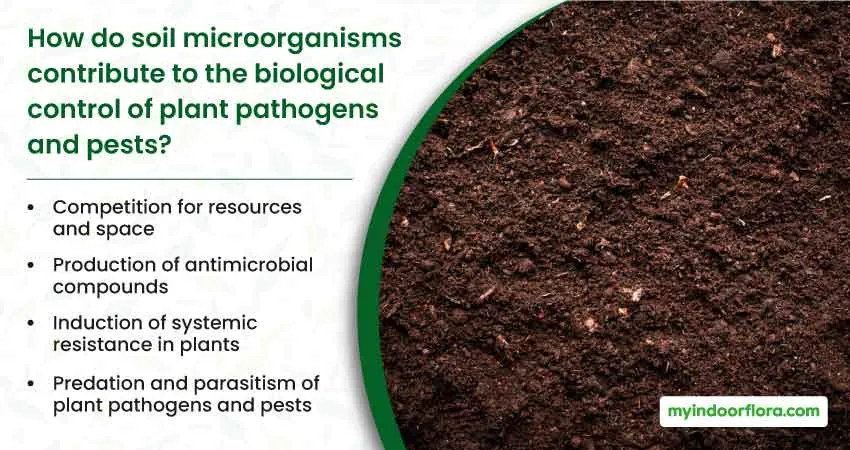
Soil microorganisms can help protect indoor plants from diseases and pests through various mechanisms.
Competition for resources and space
Beneficial microorganisms can outcompete pathogens for resources such as nutrients, water, and space, effectively suppressing their growth and spread. For example, Trichoderma species are known to compete with pathogenic fungi for nutrients, inhibiting their growth and reducing the incidence of disease.
Production of antimicrobial compounds
Some soil microorganisms can produce antimicrobial compounds, such as antibiotics, enzymes, and volatile organic compounds, that inhibit or kill plant pathogens. For example, certain strains of Bacillus and Pseudomonas bacteria produce antibiotics that are effective against a wide range of plant pathogens. Similarly, Trichoderma fungi have been shown to produce enzymes that degrade the cell walls of pathogenic fungi, suppressing their growth and spread.
Induction of systemic resistance in plants
Soil microorganisms can also enhance plant defense mechanisms by inducing systemic resistance. This phenomenon occurs when beneficial microorganisms colonize plant roots and trigger a defense response in the plant, making it more resistant to pathogens and pests. For instance, researchers have found that certain strains of Pseudomonas bacteria can induce systemic resistance in plants, leading to a reduced incidence of diseases caused by various pathogens.
Predation and parasitism of plant pathogens and pests
Some soil microorganisms are natural enemies of plant pathogens and pests, either by directly consuming them or by parasitizing them. For example, beneficial nematodes, such as those belonging to the genera Steinernema and Heterorhabditis, can parasitize and kill insect pests, making them effective biological control agents. Similarly, certain fungi, like Arthrobotrys, can trap and consume nematodes that are harmful to plant roots.
How do soil microorganisms promote plant growth and stress tolerance in indoor plants?
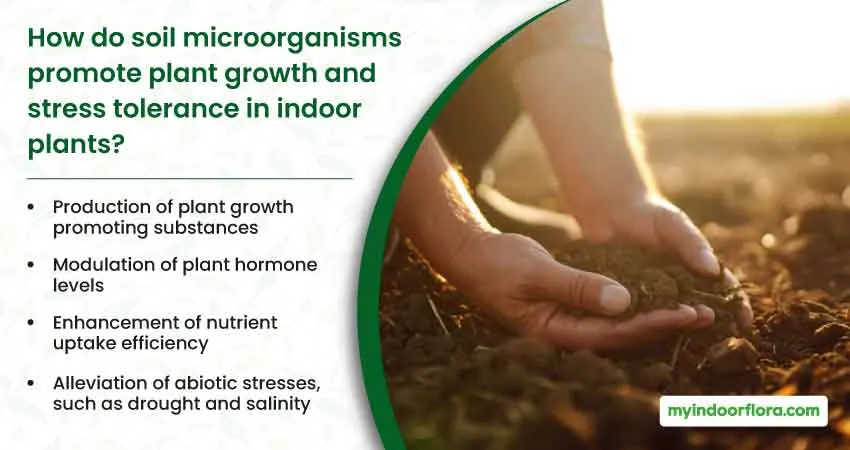
In addition to their roles in nutrient cycling and biological control, soil microorganisms can directly promote plant growth and stress tolerance.
Production of plant growth-promoting substances
Some soil microorganisms can produce substances that directly stimulate plant growth, such as phytohormones, vitamins, and enzymes. For example, Azospirillum bacteria are known to produce plant growth-promoting substances like auxins and gibberellins, which can enhance root development and overall plant growth. Similarly, researchers have found that certain fungi can produce enzymes that degrade complex organic compounds, making them available for plant uptake and promoting growth.
Modulation of plant hormone levels
Soil microorganisms can also influence plant growth by modulating the levels of plant hormones, such as auxins, gibberellins, and cytokinins. These hormones regulate various aspects of plant development, including cell division, elongation, and differentiation. Researchers have found that certain strains of Rhizobacteria can modulate plant hormone levels, leading to increased root growth and enhanced nutrient uptake.
Enhancement of nutrient uptake efficiency
Soil microorganisms can improve plant nutrient uptake efficiency by solubilizing and mineralizing nutrients, as well as through symbiotic relationships with plant roots. For instance, mycorrhizal fungi can significantly enhance plant nutrient uptake, particularly phosphorus, by extending their hyphae into the soil and increasing the root surface area.
Alleviation of abiotic stresses, such as drought and salinity
Soil microorganisms can also help plants cope with abiotic stresses, such as drought and salinity, by producing osmoprotective compounds, improving water-use efficiency, and enhancing nutrient uptake. Researchers have found that certain strains of Arbuscular mycorrhizal fungi can improve plant drought tolerance by enhancing water uptake and maintaining plant water status under drought conditions.
How to maintain a healthy soil microbial community in indoor plant systems?
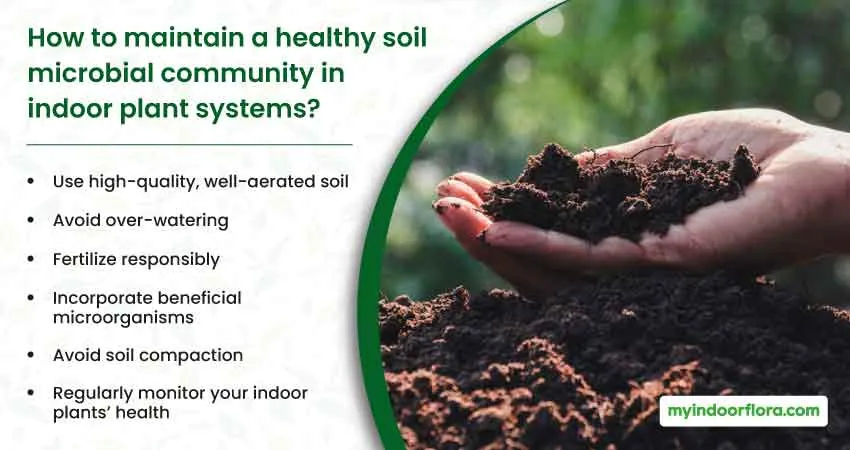
To ensure a healthy soil microbial community in indoor plant systems, it is essential to create an environment that promotes their growth and activity. Here are some practical tips for maintaining a thriving soil microbiome:
Use high-quality, well-aerated soil
Choose high-quality, well-aerated soil that contains a diverse array of organic matter, such as compost, peat moss, or coconut coir. This will provide a suitable habitat and food source for soil microorganisms, allowing them to thrive and perform their essential functions.
Avoid over-watering
Over-watering can lead to waterlogged soil, which reduces oxygen availability and can negatively impact the growth and activity of aerobic soil microorganisms. Ensure proper drainage and water your indoor plants according to their specific needs to maintain a healthy soil environment.
Fertilize responsibly
While fertilization is essential for providing nutrients to indoor plants, excessive or improper use of chemical fertilizers can harm soil microorganisms and disrupt the delicate balance of the soil ecosystem. Consider using organic or slow-release fertilizers, and always follow the recommended application rates and guidelines.
Incorporate beneficial microorganisms
Inoculating your indoor plant soil with beneficial microorganisms, such as mycorrhizal fungi and nitrogen-fixing bacteria, can help establish a diverse and robust microbial community. Commercially available microbial inoculants can be used, or you can create your own by adding compost or well-aged manure to the soil.
Avoid soil compaction
Soil compaction can restrict the movement and activity of soil microorganisms, as well as limit root growth and nutrient uptake. To prevent compaction, avoid walking on or disturbing the soil around your indoor plants, and consider using a light, well-aerated soil mix.
Regularly monitor your indoor plants’ health
Regularly inspect your indoor plants for signs of nutrient deficiencies, pests, or diseases, as these issues can indicate an imbalance in the soil microbial community. Addressing these problems promptly and maintaining proper plant care practices will help ensure a healthy soil microbiome and thriving indoor plants.
What are the potential risks and challenges associated with soil microorganisms in indoor plant systems?
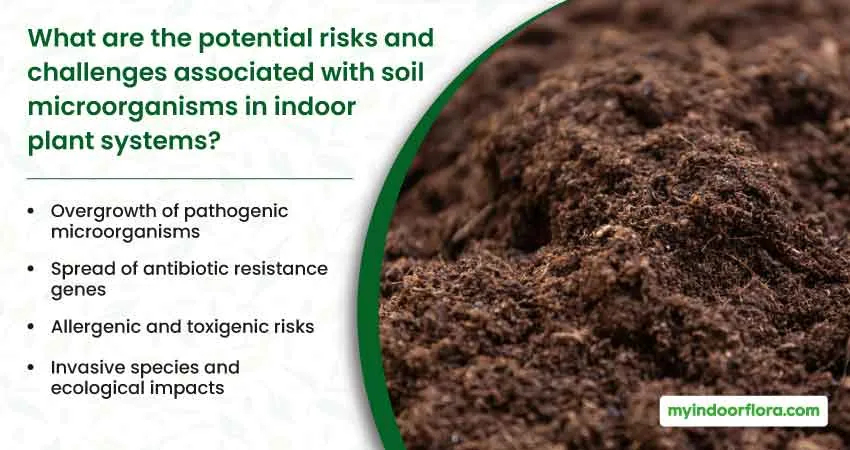
While soil microorganisms offer numerous benefits for indoor plant health, they can also present certain risks and challenges. It is essential to be aware of these potential issues and take appropriate measures to minimize their impact.
Overgrowth of pathogenic microorganisms
An imbalance in the soil microbial community can lead to the overgrowth of pathogenic microorganisms, which can cause diseases in indoor plants. To prevent this, maintain proper plant care practices, such as avoiding over-watering and using well-draining soil, which can help create an environment that favors beneficial microorganisms and suppresses pathogens.
Spread of antibiotic resistance genes
Some soil microorganisms can harbor antibiotic resistance genes, which can potentially spread to other microorganisms, including human pathogens. This is a growing concern in both agricultural and indoor plant systems. To minimize this risk, avoid using chemical fertilizers and pesticides that may contribute to the selection and spread of antibiotic-resistant microorganisms. Instead, opt for organic or biological control methods to manage plant diseases and pests.
Allergenic and toxigenic risks
Certain soil microorganisms, such as molds and fungi, can produce allergens and toxins that may pose health risks for people, especially those with allergies, asthma, or compromised immune systems. To minimize exposure to these allergens and toxins, maintain proper humidity levels and ventilation in your indoor plant environment, and promptly address any signs of mold or fungal growth.
Invasive species and ecological impacts
Introducing non-native or invasive microorganisms into indoor plant systems can have unintended consequences for the local environment and ecosystems. For example, some invasive species may outcompete native microorganisms, disrupt ecological processes, or spread diseases to other plants or animals. To mitigate this risk, use locally sourced or native microorganisms whenever possible, and follow best practices for managing and disposing of indoor plant materials and soil.
Conclusion
Soil microorganisms play a crucial role in maintaining indoor plant health, contributing to nutrient cycling, soil structure improvement, biological control of plant pathogens and pests, and direct promotion of plant growth and stress tolerance. By understanding the diverse functions of these microscopic organisms and providing an environment that fosters their growth and activity, we can harness their potential to support the health and vitality of our indoor plants.
